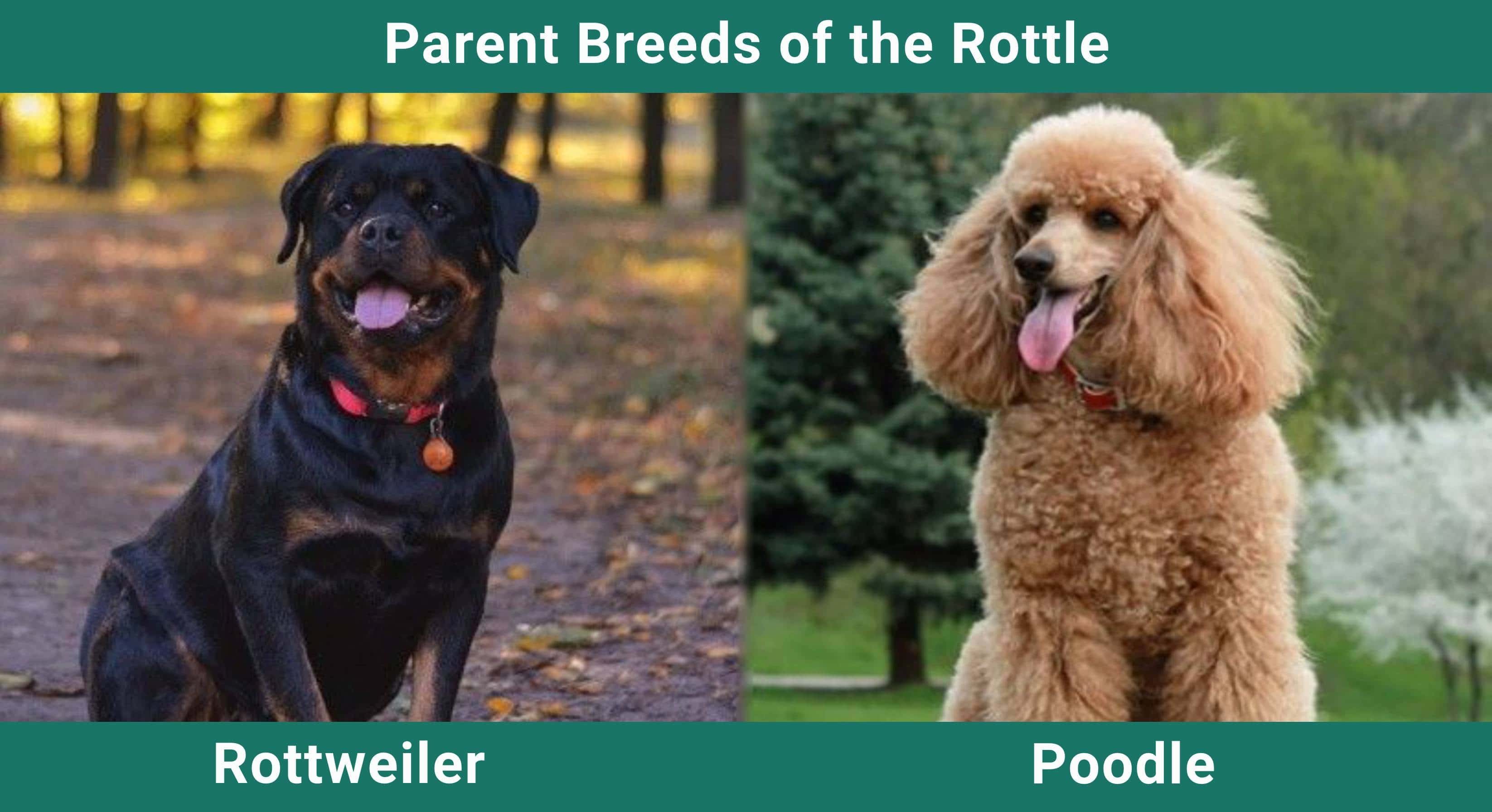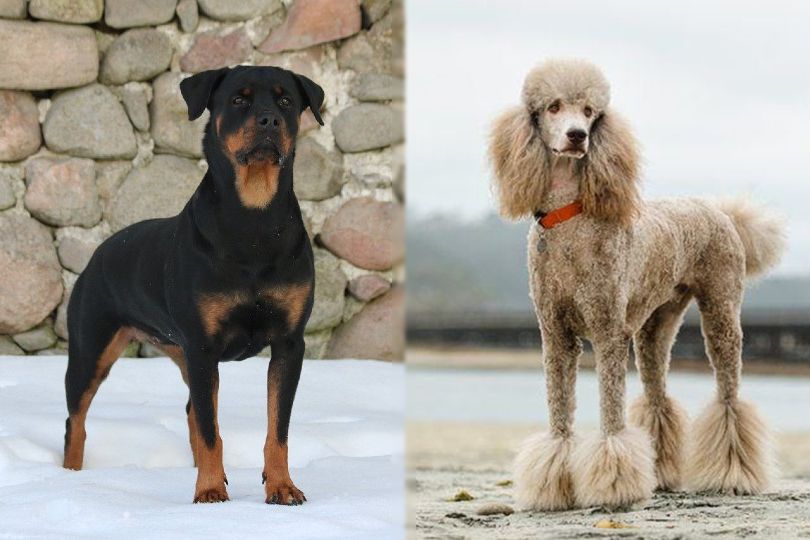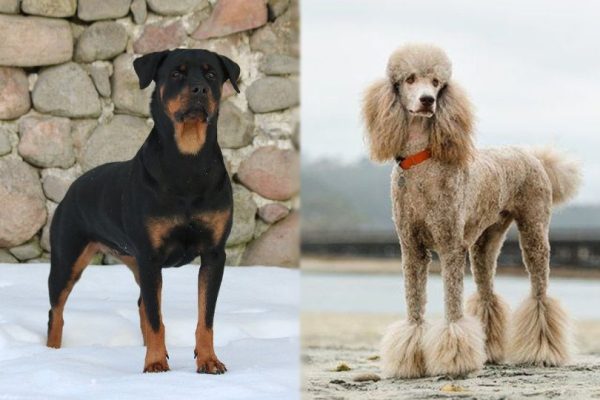Click Below to Skip Ahead
The Rottle is a cross between the Rottweiler and the Poodle dog. This makes them a mixed dog breed and the puppies inherit the parents’ appealing personalities and appearance. They are considered a designer dog breed with an affectionate, social, and loyal personality.
Breed Overview
Height:
16 – 27 inches
Weight:
60 – 90 pounds
Lifespan:
10 – 15 years
Colors:
Gray, red, blue, white, brown, black, particolored
Suitable for:
Active families looking for a guard dog
Temperament:
Loyal, protective, & intelligent
They have a medium stature and are well-built with a soft coat that they inherit from the standard Poodle. They are eager to please and less common amongst dog owners which is why owning them is so rewarding.
If you are interested in an attractive, yet affectionate dog breed, then the Rottle may be right for you.

Rottle Puppies
Rottles are a fairly affordable breed to come by, and you can purchase them from pet stores or breeders. Ideally, you should check if your local shelter or rescue center has a Rottle up for adoption.
They make good guard dogs so if that is what you are looking for, you will be happy with this loyal pup.

Temperament & Intelligence of the Rottle
Are These Dogs Good for Families? 👪
This is a highly intelligent dog that is great for families with children. The Rottle is a superior protector who is loyal to their family and eager to please. Furthermore, the Rottle is generally undemanding and family-orientated. This dog breed will enjoy playing with older children in the garden and going for long walks as a family in the evening.
Due to the Rottle’s large size and protective nature, they should only not be allowed within direct contact of small children who may pull their ears in interact with them wrong. As with all dogs, the Rottle will respond negatively if they have not been properly introduced to small children, such as barking or growling.
Aside from their striking appearance that many believe makes the Rottle appear fierce or aggressive, they are not any different than other medium or large dog breeds. They have no aggressive tendencies unless provoked, which is a natural reaction. They may look scary, but they are just gentle giants!
Does This Breed Get Along with Other Pets? 🐶 😽
The best four-legged companion for a Rottle is other dog breeds. This is because the Rottle does not seem to appreciate cats and vice versa. If your Rottle has been socialized with a certain cat from an early age, they will tolerate them in the same household. It may take longer for a Rottle to get used to a cat’s presence once they reach adulthood and have no experience with cats.
Avoid keeping rodents or birds with Rottle’s as their natural hunting instinct will see these small creatures as prey. Otherwise, all rodents and birds should be kept in a secure location where your Rottle has no access to them, even if a door or gate was to be accidentally left open.
Things to Know When Owning a Rottle
Food & Diet Requirements 🦴
The Rottle is not overly energetic, but they do require a diet high in protein to stay healthy. If you have an active Rottle who does many strenuous activities throughout the day, you may need to increase their protein and caloric content so that they can conserve their energy throughout the day.
Amino fatty acids are essential for your Rottle, as they help to keep your coat, eyes, and joints in good health. On a poor-quality diet, your Rottle may suffer from skin issues which will result in the fur becoming tough and wiry.
A raw food diet is a great idea for Rottle’s. This can include organic food sources such as meat-based protein, vegetables, and supplements. Their diet should be recommended by a veterinarian, and you may have to switch up their diet if they develop any allergies or health conditions that require special food.
Feeding your Rottle a portion of food in the morning and evening is a good idea. If your Rottle is particularly active, then three meals a day will suffice. Just ensure that the diet is balanced and FDA-approved.
Exercise 🐕
Rottle’s require a household with a large garden where there is sufficient space for them to run, play, and keep active. If your Rottle is cooped up in a small area for a long period, they may begin to display behavioral issues due to boredom.
Stimulation in the form of toys and playtime is essential. This allows your Rottle to release energy healthily. You can play fetch with your Rottle or provide them with plenty of toys to chew on. If you have multiple dogs, you can even encourage them to play together outside by giving them interactive toys.
Your Rottle will be happy to accompany you on a walk, hike, or short-run during the early morning or evening when it is not too hot or cold. During this time they will need plenty of water and shade when necessary, so only exercise them in dog-friendly areas.
Training 🎾
This dog breed is easy to train. You can teach them to do tricks such as sit, stay, follow, or rollover, especially if treats are used as encouragement. Furthermore, you can potty train Rottle’s so that they do not leave messes indoors. You can also train your Rottle to do various obedient or agility courses, as they are agile and strong dogs that benefit from mental stimulation and exercise.
Positive reinforcement is a great way to train your Rottle to do certain obedience tricks. Shouting and punishing your Rottle for a mistake may make them fearful to try the activity again. If you feel your Rottle is difficult to train, then contacting a canine behaviorist will help solve the problem.
Grooming ✂️
The Rottle does not have high grooming demands and caring for their coat is easy. Weekly brushing is necessary to get rid of any loose hair that accumulates on their coat. They should be washed at home every few months to get rid of any dirt and debris, but too often to the point where they lose natural oils from their coat.
Taking your Rottle to a dog parlor every few months is a good idea. Here they can brush, wash, and clip your dogs’ nails, giving them a professional shine afterward.
Health and Conditions 🏥
- Obesity
- Arthritis (common over the age of 6 years)
- Cataracts
- Overgrown nails
- Lymphoma
- Heart issues
- Hip or elbow dysplasia
- Corneal dystrophy
- Cancer
- Respiratory distress
- Mange
Male vs Female
At first glance, it may be difficult to determine the gender difference in this dog breed, but upon closer inspection, there are slight varying differences.
The female Rottle is stockier and rounder than their male counterparts. The head may appear larger, accompanied by a short neck and wide-set legs. Females are more prone to obesity than male Rottle’s, and it can easily be seen by their large bodies. In comparison, female Rottle’s are slower and more excitable than males. Many owners claim their female Rottle has a maternal instinct over the families’ children and will do anything to protect them.
Male Rottle’s are slightly taller than females, but not as broad. They have long legs and a sleek chest with a defined neck. They are not as strong as female Rottle’s as they lack the weight seen in females. However, they are known to be faster and more agile.
3 Little-Known Facts About the Rottles
1. The Rottle goes by many names.
This dog breed also goes by the names of rottiepoo or rottiedoodle. This is a mixture of their parents’ names (Rottweiler and Poodle).
2. It’s a mixture of purebred dogs.
The Rottle was first created in the 1980s by breeding a purebred Rottweiler and Poodle.
3. It’s a rare mixed breed.
This is a designed dog breed that makes them rare to come across.
Conclusion
Overall, the Rottle is a great dog, both for families and sole owners alike. With their high intelligence, controlled energy levels, and loving personality, it is easy to see why the Rottle makes such a good hybrid dog breed. If this article has interested you, it may be time to bring a Rottle into your loving home and experience their delightful nature for yourself.
Featured Image Credit: Left – K L, Pixabay; Right – everydoghasastory, Shutterstock









